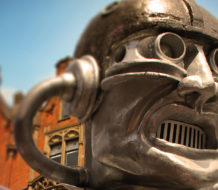In late March, I met Actroid-F in the University of Southern California’s (USC) Doheny Memorial Library. Part of an interactive showcase on “thinking and feeling in the age of synthetic humans,” she is a remarkably persuasive android. Sitting at her station in a beige cardigan with hair in a ponytail, she leans forward with an expression of empathetic concern and asks the crowd how we are doing. I walk up for a closer look and make eye contact, surprised by the blink that greets me. Her makers, like humanoid researchers in general, seek to simulate aspects of the human body, including movement, especially difficult in the face, described by Ludwig Wittgenstein as the soul of the body with its ability to emote. A “telerobot,” Actroid-F can be wielded by a remote operator through a motion-capturing system, imitating gestures and enunciating words, in effect transmuting a human presence via pneumatic actuators. It is easy to focus on her uncanny female-likeness, and so on the ghost in this particular machine, but that would risk missing the bigger picture: the importance of ephemeral qualities like “emotion” in this new generation of robots.
Get BQO by E-mail
ESSAYS
-

What Is Moral Injury?
-

What Does It Mean to Have Free Will?
-

Should We Fear Robots?
-

Do We Need Purposes in Biology?






